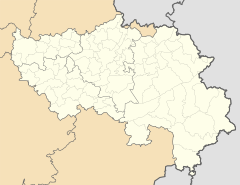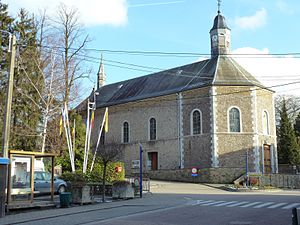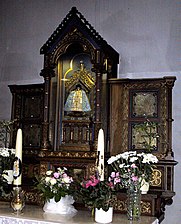Moresnet Chapelle
| Moresnet Chapelle | ||
|---|---|---|
|
|
||
| State : |
|
|
| Region : | Wallonia | |
| Province : | Liege | |
| District : | Verviers | |
| Coordinates : | 50 ° 44 ′ N , 6 ° 0 ′ E | |
| Post Code: | 4850 | |
| Prefix: | 087 | |
Moresnet-Chapelle ([ mɔ.ʁɛs.nɛt ], ndl .: "Eiksken"; popularly "Eichschen"; synonymous with small oak) is a district of Plombières in the Walloon region of the province of Liège in Belgium . After the fall of Napoléon Bonaparte in 1815, the place initially belonged to the Kingdom of the Netherlands and in 1830 became part of the new state of Belgium. The official language is French, and many residents also speak German or their Limburg dialect.
Characteristic
The hamlet , which originally belonged to the village of Moresnet , has been a place of pilgrimage to Our Lady since the early 19th century . The Dutch and German / dialectical place names "Eiksken" or "Eichschen" go back to the small oak tree on the edge of the hamlet, on which the miraculous image of Mary, with which the pilgrimage to Moresnet began, was located. After the Chapel of Mercy was built in 1823, the hamlet was named Moresnet-Chapelle and has been part of Plombières since 1977.
With around 150,000 visitors annually, the hamlet has developed into a place of pilgrimage , with numerous pilgrims from Aachen coming to Moresnet every Wednesday since 1863 . The way there and the place of pilgrimage itself are part of the Way of St. James , which leads as "Path 1" of the "North Rhine Way of St. James" from Beyenburg via Cologne and Aachen to Liège . In the course of this, more and more cafes, restaurants and souvenir shops were built in the village, the place was constantly being beautified and the central square and the thoroughfare from Kelmis to Gemmenich were repaired.
The “Foyer Jean Arnold”, which is under the patronage of the Bishop of Liège , was named after the chaplain Jean Arnold , who was known in the region and who was beheaded in 1944 in the Brandenburg penitentiary . Until 1880 there lived in the foyer Franciscans who had come to Moresnet from Aachen because of the Prussian Kulturkampf , before they could move into their own new convent at the Gnadenkapelle. After several intermediate owners, the Jean Arnolds Foyer has been used since 1975 by a subsection from Spa des Foyers de Charité , an association of believers who, following the example of the early Church, live in community and share their goods.
In addition, the “Résidence Regina” senior citizens' home and the “Center de soins St-Joseph” nursing home with a palliative care facility and a geriatric outpatient clinic, which is attached to the St. Nicholas Hospital in Eupen , were built.
A tourist attraction are the extensive forest areas in the east of the village, which flow smoothly into the Aachen forest on the German side and the forest areas of the Vaalserberg on the Dutch side.
Pilgrimage site
After the farmer's boy Peter Arnold Frank (1741–1801) was cured of epilepsy by invoking a miraculous image of Our Lady and also two cattle epidemics in 1771 and 1794 could be averted by the prayers of the farmers at this miraculous image, the idea arose through a citizens' association To build the place as a pilgrimage center. In 1876, through the mediation of Franziska Schervier, the order of the Franciscans settled in Moresnet, because as a result of the monastery law of May 31, 1875, almost all monasteries in Prussia had been abolished. Until 2005 the Franciscans looked after the pilgrimage site with a short interruption, had a pilgrimage church and a monastery built, and built a calvary with a way of the cross in a park area . After the Franciscans left in 2006, the Community of Crucified and Risen Love, an association of believers from Maastricht , took over the care of the pilgrimage site in 2014 .
Web links
Individual evidence
- ↑ Martin Thull: How Moresnet became a magnet for pilgrims , in Aachener Zeitung from June 16, 2014
- ^ North Rhine-Westphalian Way of St. James
- ↑ Jean Arnold foyer
- ↑ INAGO
- ↑ The Franciscan Monks in Moresnet Chapel - Father Johannes Ruiter, founder of the Way of the Cross in Moresnet Chapel , on trois-frontieres.be
- ↑ Apollinari Church in Remagen






